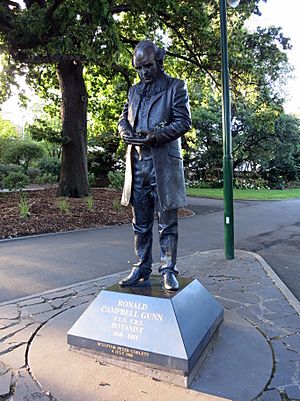Ronald Campbell Gunn facts for kids
Ronald Campbell Gunn (born April 4, 1808 – died March 13, 1881) was an important Australian scientist and politician. He was born in South Africa but spent most of his life in Tasmania, Australia. He was especially known for studying plants, which is called botany. He was even a Fellow of the Royal Society, a very respected group of scientists.
Contents
Ronald Gunn's Early Life
Ronald Gunn was born in Cape Town, which is now part of South Africa. His father, William Gunn, was a soldier in the British Army. Ronald traveled with his father to places like Mauritius and the West Indies. He also went to Britain for his education.
He started working for the Royal Engineers in Barbados. But in 1829, he moved to Van Diemen's Land, which we now call Tasmania. There, he became a supervisor for convict barracks in Hobart.
Gunn's Career and Discoveries
In 1830, Ronald Gunn moved to Launceston and continued to work with convicts in northern Tasmania.
Becoming a Botanist
In 1831, Gunn met Robert William Lawrence, another early botanist in Tasmania. Lawrence helped Gunn become very interested in plants. He also introduced Gunn to famous botanists like Sir William Jackson Hooker. Gunn wrote letters to these scientists for many years, sharing his discoveries.
In 1836, Gunn became a police magistrate in Circular Head. From there, he explored many parts of Tasmania. He also visited Port Phillip and Western Port in mainland Australia.
Working for the Government
By 1838, Gunn was an assistant police magistrate in Hobart. A year later, in 1839, he became the private secretary to Sir John Franklin, who was the governor of Tasmania. He also worked as a clerk for the government councils.
In 1841, Gunn left these jobs to manage the properties of William Effingham Lawrence. This gave him more time to study the plants of Tasmania.
A Scientist of Many Talents
Ronald Gunn was not just interested in plants. He became a general scientist. He collected many different animals, including mammals, birds, reptiles, and molluscs (like snails and shells). He sent these collections to the British Museum in London.
He also started studying geology, which is the study of rocks and the Earth. The government hired him to report on mining areas and other natural resources in Tasmania.
Choosing a Capital for New Zealand
In 1864, the government of New Zealand asked Ronald Gunn to help them choose a new capital city. He was one of three experts from Australia who recommended moving the capital from Auckland to Wellington.
Later, he became a recorder of titles in Launceston. He held this job until 1876, when he retired because he was not well.
Gunn's Scientific Legacy
Ronald Gunn was a fantastic botanist and a skilled general scientist. Sir Joseph Dalton Hooker, another famous botanist, even dedicated his book Flora Tasmaniae to Gunn. Hooker praised Gunn's amazing ability to observe plants and collect specimens. He said Gunn had a special talent for noticing important details about plants that few experienced botanists possessed.
Published Works and Societies
Even though he was very skilled, Gunn did not publish many books or papers himself. He did write a paper with Dr. John Edward Gray about animals and fish from Tasmania. He also wrote a few papers about the geology and plants of the island.
When he was Sir John Franklin's secretary, Gunn helped start a science journal called the Tasmanian Journal of Natural Science. This journal published papers that were read at the governor's house. This was the beginning of what later became the Royal Society of Tasmania, a very important scientific group.
Gunn also served as a politician in the Tasmanian Parliament between 1855 and 1860. He was well-liked and respected by many. He is considered one of the most important botanists from Tasmania.
Ronald Gunn passed away on March 13, 1881, at his home near Launceston. He is remembered by the names of two plant groups, Gunniopsis and Gunnia, and many plant species.


